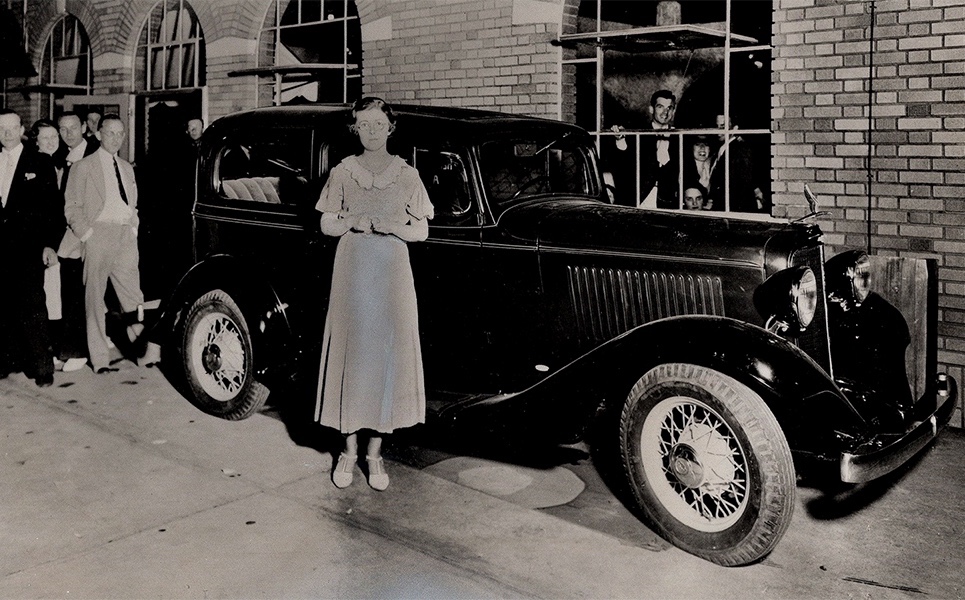Mom's New Car

Photo Credit: The Rigney/Cunningham Families - Historic Value - All Rights Reserved'
Audio Credit: "Sing!, Sing!, Sing!" - By: Benny Goodman and His Orchestra - From the Album: The Essential Benny Goodman
Dear Reader, I hope you enjoy this modest story of love and hard work, one of countless that, considered alone, probably don\'t amount to much, but considered together, brought unity and immense strength to bend the arc of history in our vast land. It starts in my father\'s gigantic \'66 Pontiac Bonneville, careening southbound on Route 12 between Utica and Binghamton, getting 6 - 7 miles per gallon (which my contrarian father was ever so proud of!), my brothers fighting and cackling as my venerable and equally contrarian Great Aunt Maddie shouted stories of her childhood in Ireland. In between radio updates of baseball scores, we hated the English. We knew dozens of relatives we\'d never meet. We snickered through Hail Marys in gratitude for our full bellies. It was the war stories that got us to pipe down. The one about my uncle, my mother\'s brother, who won a Battlefield Commission in the Hurtgen Forrest, because virtually everyone else in his Company was killed. Another uncle, my father\'s brother, a highly decorated Marine, wounded on Iwo Jima and then again in Korea. And my personal favorite: yet another uncle, a hotshot carrier pilot, knocked down in rank and forced to retire shortly after VJ Day for flying his Corsair Under(!) The Pulaski Skyway Bridge! My father claimed his worst wound occurred getting kicked in the shins by \"those GD Protestants\" playing soccer in Scotland (while he recovered from a compound fracture that shattered his elbow for life). They all refused to talk about it so it was left to Aunt Maddie. Ignored, in a sign of the times, my mother, Maddie\'s niece, was a heroine of an equally valid, although different sort.
Let\'s swing back 35 or 40 years (we\'ll let you borrow the Bonneville), or defiantly stride forward about 50 from my great Aunt\'s harrowing, yet proud memories of Irish famine. Which brings us to that defining moment in World History, the Great Depression. My mother\'s home town, Binghamton, was, like many cities, resilient. On the main train route from Chicago to New York, Binghamton\'s \"George F.\" Pavilion exuberantly hosted a cavalcade of Big Bands from all over the country. First for free, during the war for a buck, that went to the war effort. The banner photo for this essay is of of my mother, Mary Eileen, who at age 16, at a Benny Goodman concert, has just won the car she\'s standing in front of! \"Sing! Sing! Sing!\" She had no idea how to drive it, so in response to her request (read petulant demand - she was Irish!) for driving lessons, she gave the car to my grandparents. A quick aside: How many of us had moms who could drive stick shifts!?
My cousins, the girls on both sides of my family, have for decades debated over who had the better deal: My mother, who won the car, or her sister, my Aunt Betty, a raging beauty who several years later stole a kiss from the Tommy Dorsey Band\'s lead singer, Frank Sinatra! That question was naturally followed by the question more vexing to my cousins; who stole the kiss from who? Whether apocryphal, a tall Irish tale, or the God\'s honest truth, these are the stories that bind families together. More constructive than the war stories, they always involved the strong women who were, and remain, our family\'s backbone. Shared with the neighbors, they made our neighborhood the coolest in town!
Without exaggeration, her new wheels gave wings to my mother, and helped her entire family weather the Depression. She soon went to Nursing School, embarking on a career that would span close to 50 years, that would empower her in our modern sense of the term: independence, income, and self reliance. Nursing gave her the opportunity to reconcile her Empowered Strength with her devout Catholic Compassion. She conceived of her career, and made it work on her own, in an epoch when young ladies needed a champion to achieve success.
As World War II loomed, my mother enrolled in the Public Health Nursing Program at Case Western Reserve. Whereas most nurses care for one patient at a time, public health nurses care for entire communities, providing education and advocacy, as well as screening for epidemic vectors. 15 years before the vaccine, Polio was a feared scourge that struck many, including the President. Several epidemics occurred during the war and before the vaccine. Many people avoided crowds and public gatherings, such as county fairs, sporting events, and parades, afraid of contracting polio. What\'s that remind us of today? But like a modern firefighter, and the exhausted, heroic nurses of today, my mother moved toward infection, hot spots, and disease. As fearless as the bravest war hero, ignoring consequences to herself. She tested positive for half a dozen serious diseases, including tuberculosis, as well as the pernicious diseases that passed from farm animals to humans. She was amazingly tough!
When my mother met my father, she was the Only Public Health Nurse in Chenango County, New York - covering every school and farming community in the county. I\'m not sure how they found time to see each other, my father was also working continuously and urgently - heavy construction of the Thruway and heavy engineering at Griffiss Air Force Base. Together, with their neighbors and communities, they dominated the largest war in history, and then turned their attention to shepherding America into modernity and prosperity. They knew what they were participating in. Their hard work coalesced with that of others, to generate the enormous, transcendent power that changed the world and created the powerful history we are challenged to live up to today.
As the polio vaccine emerged, My mother encountered much of the fear and disbelief that in our time, has greeted efforts to vaccinate for covid. She was an explorer, a pioneer, helping to establish the science, that should be accepted fact by now. We have no excuse. In the mid 50s, Radios were ubiquitous, sure. It was a time of transition from the beautiful, tube driven radios of the Swing Era to cheaper, smaller transistor radios. Television was still a luxury in the agricultural communities. So my mother\'s role was to travel from village, to hamlet, to school to educate about the polio vaccine, often to a mixed reception. Exhausting, difficult work, and then in the middle of it, my parents discovered that a stolen trip to the Adirondacks miraculously worked as planned, and your\'s truly was on the way! All pregnancies are miraculous, especially my mother\'s. My folks were older than most new parents, My mother\'s three pregnancies were fraught and dangerous - I was a breech birth born after my mother\'s labor of thirty hours. First and foremost a nurse, when I came of age mom charged me to give blood, with enthusiasm and abundance, because she lost so much when I was born. To this day I\'ve given blood 300 plus times, including Apheresis which I\'ve done an easy 25 times. I keep track; it sounds good in totality and I\'m proud of it. But do the math. I\'ve given blood for 50 years, since I was a senior in high school. It averages out to five or six times a year, a half hour commitment every couple of months. The Apheresis takes longer, but the platelets that are taken are used to heal burn victims. I do that once every couple of years. Giving blood is a force multiplier. A small, easy gesture with expansive, life saving results for those helpless due to injury or sickness. My brothers and I do it to keep faith with the beautiful woman who, despite being too old to do so, brought us into this world. We extend her commitment and good will beyond her life. So give blood for my mother, give blood for my uncles. Most importantly, give blood for your families, who we all know have stories just as compelling as the one I tell.
An Irish Proverb instructs: \"It is in the shelter of others that people live\". In so many ways the trajectories of other people\'s lives intersect with and influence our own, the work that we do, how we live, how we remember. It\'s why we tell stories. We confirm our present and build our future through the stories we tell. Culture and statecraft in America aren\'t organized around an historic dominant ethnic group, a particular religion, or for that matter, two thousand years of history. Ours, at its best, is much more dynamic. It\'s organized in recognition of multiple ethnic groups, and the stories they tell, which reveal common qualities among all. The very act of telling our stories strengthens Unity. However, our history is rife with national tragedy, because our stories are incomplete. We have truncated our national origin story, by murdering the original native inhabitants of the land, and torn gaping holes of ignorance in our subsequent history, by shamelessly attempting to obscure the enslavement of African Americans. Our larger story, with some wonderful exceptions, is dark. Our mother, always a devout Catholic, worked in a small but significant way to restore the moral balance. She ended her career by working at the VNA, The Visiting Nurses Association, bringing medicine and care to those in Utica, NY who couldn\'t receive it any other way. Needless to say, she, and her fellow nurses, were busy. We tell her story today to shed light on her work, and its effect, which was to bring shelter, to empower others to share their story, to participate in our growing, powerful society. We live in the shelter of women like my mother. Inherent in the shelter provided, there resides a very high standard, as well as a challenge. To meet this historic challenge, let\'s first meet the high standard set by women in the recent past. Let\'s continue to strive for unity between each other, for harmony with nature, and to share what we achieve with all. Thank You.
A Note: Please take a few minutes and listen to the accompanying music. Among Jazz Fans, this recording is famous. Written by Louis Prima, Benny Goodman and His Orchestra first recorded \"Sing! Sing! Sing!\" in the summer of \'37, which puts it a couple years out of sync with my mother\'s photo. That\'s OK, for by the beginning of WWII it was \"All The Rage\", bringing the warmth of home to citizen soldiers across the globe. For neophytes, this recording features Goodman on the clarinet, of course; but also Gene Krupa on the long, difficult drum pieces and Harry James, soon to start his own band, on the trumpet. Three superstars in their present tense, in their prime. Audio recordings add so much dynamic joy to the History Chip format, bringing context and richness to the written word. Turn your volume down a little to enjoy the music while you read. Then crank it up and grab your dance partner! (Hey Fred! Where\'s Ginger? Show us how it\'s done!)...But that\'s another post... In the meantime, Enjoy!!!
1930's

To leave a comment, please Signin or Register.